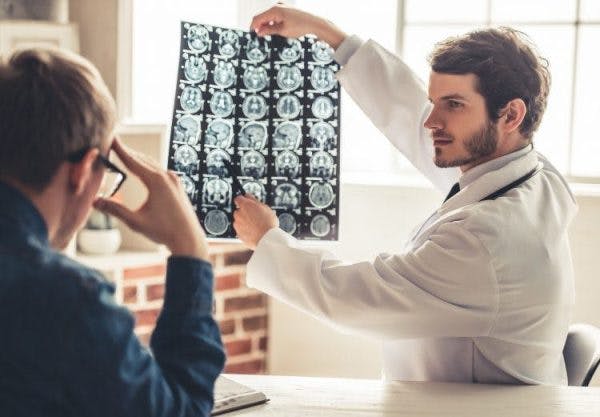Damage to the brain may be minimal following a mild traumatic brain injury or concussion, or it may be more extensive following severe injuries, such as a diffuse axonal injury. In either case, recovery begins when the brain starts healing itself. This begs the question: how does the brain repair itself after a traumatic injury?
The brain is incredibly resilient and possesses the ability to repair and rewire itself through the process of neuroplasticity. This phenomenon is the reason why many brain injury survivors can make astounding recoveries.
This article will provide an overview of this healing process and provide practical tips on how to harness neuroplasticity after brain injury to promote an optimal recovery. Use the links below to jump directly to any section:
- Understanding how the brain works
- What happens after a traumatic brain injury?
- How does the brain heal itself?
- Use it or lose it: the importance of repetition
- Optimizing neuroplasticity for recovery
Understanding How the Brain Works
In order to understand how the brain can repair itself after a traumatic injury, it is essential to have a good idea of how the brain works. The average human brain contains approximately 86 billion neurons, which communicate to one another through a network of 100 trillion connections, referred to as synapses.
Created through a combination of genetics and experience, synapses are actually small gaps between neurons through which signals can be transmitted. When similar experiences are repeated, synaptic connections are strengthened. Alternatively, when synapses are not used regularly, connections can weaken or be lost completely.
This process of creating, strengthening, and losing synaptic connections, referred to as neuroplasticity, occurs throughout an individual’s lifetime. In fact, when a baby is born, they have only around 50,000 synaptic connections.
However, as they grow, learn, and develop, this number rapidly multiplies. By age 1, one billion synapses have formed. By age 3, the brain may have up to twice as many synapses as it will have in adulthood. Some of these synaptic connections may continue to be strengthened, while many others will be lost due to disuse as the child grows into adulthood.
Because of neuroplasticity, the brain is constantly changing. Although connections are consistently being made and reorganized, there are certain periods of time that the brain experiences a greater rate of neuroplasticity. One of these times is throughout the first few months following a brain injury.
What Happens after a Traumatic Brain Injury?
When the brain sustains damage due to a neurological injury, such as a stroke or traumatic brain injury, neural pathways may become disrupted. Synapses may be lost due to the immediate physical injury itself or because of secondary biological processes related to the injury. This impairs the brain’s ability to transmit and receive messages, resulting in functional changes.
A number of functions may be impacted after a traumatic brain injury depending on which area(s) of the brain sustained damage. For example, a frontal lobe traumatic brain injury may lead to difficulties with higher level cognitive functions, while an injury to the cerebellum may result in balance and coordination challenges.
Since each area of the brain plays a role in specific functions, brain injury survivors may experience physical, cognitive, emotional, and/or behavioral changes, depending on where the injury occurred. Functional changes may significantly impact the survivor’s ability to independently perform their activities of daily living, care for their families, complete work tasks, and pursue leisure interests.
Fortunately, with the help of neuroplasticity, new neural connections can be created and strengthened. This process of adaptive rewiring within the brain can allow survivors to partially or even fully recover lost functions.
How Does the Brain Heal Itself?
Exactly how does the brain repair itself after a traumatic injury? Neuroplasticity allows the brain to create new pathways and strengthen existing ones. This enables healthy parts of the brain to compensate for damaged areas.
This process can be compared to taking an alternative route when a frequently used street or freeway entrance has been blocked. Although this alternative route may be unfamiliar and take longer to navigate, it will still lead to the right destination.
When frequently used neural pathways are blocked due to damage, the brain may reroute messages regarding affected functions to a healthy area of the brain. This can still allow individuals to perform the function, but it may initially feel unfamiliar and challenging.
As neural pathways are strengthened, affected functions begin to improve. Neuroplasticity is enhanced during the first 3-6 months following a traumatic brain injury. Therefore, individuals can make the greatest gains during this time.
Use it or Lose it: The Importance of Repetition
As previously mentioned, the brain adapts to experiences. Therefore, when the brain encounters a certain experience or action repeatedly, the associated neural pathways are strengthened.
This is why neuroplasticity is best activated through repetition, or massed practice. The more a certain task is practiced, the stronger the related neural connections become.
Conversely, when individuals avoid using impaired skills, any remaining functions may diminish until they are lost. For instance, if a survivor experienced impaired coordination in their dominant hand, avoiding any use of that hand may result losing the ability to move the hand at all.
While spontaneous recovery is possible, participating in rehabilitative therapies or exercises after brain injury can help individuals learn specific ways to stimulate the brain and promote neuroplasticity. Physical, occupational, and speech therapists are experts in optimizing recovery. Therefore, they can tailor treatments specifically to the survivor’s strengths and areas of need to encourage recovery.
Want 25 pages of TBI recovery exercises in PDF form? Click here to download our free TBI Rehab Exercise ebook now (link opens a pop up for uninterrupted reading)
Optimizing Neuroplasticity for Recovery
Since repetition is key to promoting neuroplasticity, it is important for individuals to continue practicing affected skills even outside of therapy sessions. This is why home programs can be extremely beneficial for survivors looking to optimize recovery.
Practicing therapeutic exercises and activities can boost recovery, whether through a home program provided by a therapist or through a technology-based program. Technological programs have the added benefit of gamifying rehabilitative tasks, providing a motivating and engaging way to promote recovery. Potential programs that may be recommended include:
- FitMi: a computer-based program targeting mobility throughout the body that can adapt to one’s current functional level
- CT Speech and Cognitive Therapy App: over 100,000 exercises focused on improving speech and cognition that can be accessed anytime, whether at home or on-the-go, through an Apple or Android device
Although the fastest gains are typically made during the first few months after a brain injury, improvements can also be made after this point. However, many survivors experience a recovery plateau, where progress seems to slow or even stop. This is a normal part of the brain recovery process.
Continuing to practice therapeutic exercises and activities, both during therapy and at home, can help individuals push past a plateau and continue making improvements. While not everyone will make a full recovery after a brain injury, stimulating the brain through tasks promoting neuroplasticity can optimize recovery outcomes.
Want to learn more about the CT Speech and Cognitive Therapy App? Get Started Here.
(Link opens a pop-up for uninterrupted reading.)
Restoring Function with Neuroplasticity
However mild or severe a brain injury may be, there is hope that damaged functions may be restored with the help of neuroplasticity. The best way to boost neuroplasticity is through repetition and consistency.
Damage sustained after a brain injury can affect neural pathways and synaptic connections, potentially impairing a number of different functions. However, with consistent practice, survivors can make incredible improvements throughout the recovery process, even after the initial stage. Neuroplasticity after brain injury is not only essential for healing, but also for living a productive, more independent life.










